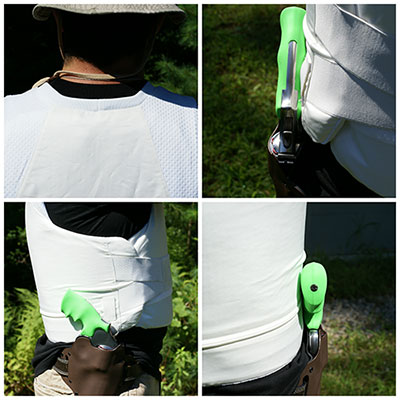From time to time, as a security guard, you're likely to encounter dangerous individuals. The regularity and the severity of risk will vary depending on the environment you work in and the type of people frequenting it, but you should always be prepared for confrontation, and to defend yourself against assault. Sadly, in some situations, criminals will use guns, knives, and other deadly weapons to clear any obstructions in their path without a second thought.
Body armor is essential for staying safe on duty, but how do you know which is best for your specific assignment and the level of expected threat? SafeGuard Clothing has put the following educational information together.
Event and Public Security
 When providing security at an event, you may need different levels of protection based on numerous factors: the theme of the event, the type of people likely to attend, and the availability of alcohol/drugs. While not all public events will experience unrest, some people can cause problems when their inhibitions are lowered.
When providing security at an event, you may need different levels of protection based on numerous factors: the theme of the event, the type of people likely to attend, and the availability of alcohol/drugs. While not all public events will experience unrest, some people can cause problems when their inhibitions are lowered.
At most events (such as music festivals and concerts), security guards will be hired to patrol and watch out for troublemakers, providing a high level of visibility. During the course of the day and night, as adrenaline peaks and the drink is flowing, people might lose control. Confronting them can expose security personnel to the risk of assault, and body armor can protect you from severe injury. As part of your job is to provide a high-profile presence to deter troublemakers, the more prepared you appear, the better.
Bullet-proof vests may not be needed at most events, but should be available just in case. Instead, stab vests and spiked weapon vests are more likely to be needed – knives are easier to smuggle in through security checks, and bottles may be broken and used as improvised weapons. Sadly, there is no one-size-fits-all vest to defend against all weapons and all threats, and so you need to evaluate which threats are most likely to present themselves.
Stab vests: Otherwise known as “edged blade vests,” these are used by security personnel and police officers across the states for reliable, efficient protection. The National Institute of Justice (NIJ) puts all vests through stringent tests to assess the amount of defense they offer by rating them by levels. Stab vests are categorized in two levels: II and III; however, there is no huge difference between the two – level III vests simply feature a tighter weave and extra layers to defend against more ferocious attacks.
These are made with multiple layers to create friction against the blade, stopping it from tearing through to flesh and bone. If a troublemaker pulls a knife, a stab vest could save your life.
Spiked weapon vests: At an event, a criminal or problematic individual might attack security personnel with an improvised weapon in the heat of the moment: a needle, a sharp shoe-heel, an icepick – almost any pointed object can prove fatal if it punctures a vital organ or severs an artery. And, if attacked with a hypodermic needle, there's also a danger of contamination.
Spiked weapon vests feature a much tighter weave than stab armor, and will stop a pointed tip passing through the material as it would with standard clothing. As a spiked weapon has a concentrated impact point, it doesn't cut materials like a knife, and these vests stop the object with multiple layers.
Security for Malls, Banks and Business Sites
 Security guards based at malls, banks and business sites are required to watch over multiple properties and hundreds of individuals. An average shift might involve anything from chasing shoplifters, tackling pickpockets, or even confronting armed thieves. Each of these situations poses significant risk of assault and injury.
Security guards based at malls, banks and business sites are required to watch over multiple properties and hundreds of individuals. An average shift might involve anything from chasing shoplifters, tackling pickpockets, or even confronting armed thieves. Each of these situations poses significant risk of assault and injury.
Each place will have its own risks dependent on the location it’s based, the potential gain it offers to thieves and its history of crimes. Bullet-proof vests may be needed for guards in some of these places, but with various different types available, how do you know which is best?
Bullet-proof vests: The NIJ categorizes bullet proof vests, or “ballistics vests” in three levels: II, IIIa, and IV. Level II vests are designed to protect against common handgun rounds, such as 9mm ammunition, up to the .357 Magnum range. Level IIIa will defend against 9mm sub-machine rounds up to a .44 Magnum range. Both of these are usually made with Kevlar, one of the most popular and reliable protective materials.
Level IV bullet proof vests feature different designs to the latter two, including panels on the front and back, into which protective panels are inserted (typically made of steel, titanium, or ceramics). These can defend against high-velocity bullets, including armor-piercing and assault rifle rounds. Plates must be replaced after use.
Covert or Overt?
Some assignments will demand a stealthy approach to security. Whether you're in plain clothes at a public event or providing close personal protection for a VIP, wearing a bulky vest over your clothing will obviously give you away. Instead, you should wear covert armor – this is thinner and more lightweight than standard vests, and usually features moisture-wicking fabrics to help you stay cool over prolonged wear.
Overt vests are the standard armor worn over clothing. These should be worn if you're hired to patrol a business site or provide a high level of visible presence at an event.
Covert/overt vests are also available, providing versatility for all situations. For example, you may need to change from plain clothes into uniform (or vice versa); you'll have the perfect solution. These are thinner than standard overt vests, and thicker than standard covert vests, with no compromise on protection.
Sizing your Vests: The Importance of the Perfect Fit
You should never underestimate the importance of finding the right vest to suit your shape – your life might depend on it. As the main job of body armor is to just protect the vital organs, you need to make sure it fits the torso comfortably, without being too tight or too loose.
If your vest hangs away from the body or clings to it too tightly, your movements will be restricted; this could prove fatal if you need to give chase, run from danger or take cover. Before you order vests from your supplier, you should take full measurements of your height and chest, and compare them to their size charts. Once you receive your vests, you should try them on and explore your range of movement: stretch, crouch, run, jump, crawl – do anything and everything you can to make sure you're comfortable and relaxed.
Click here for a few final tips to make sure you get the most out of your vest.